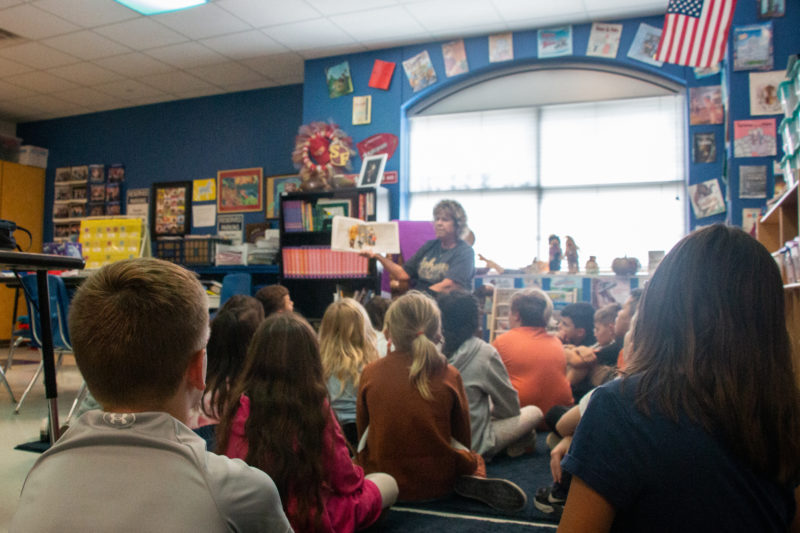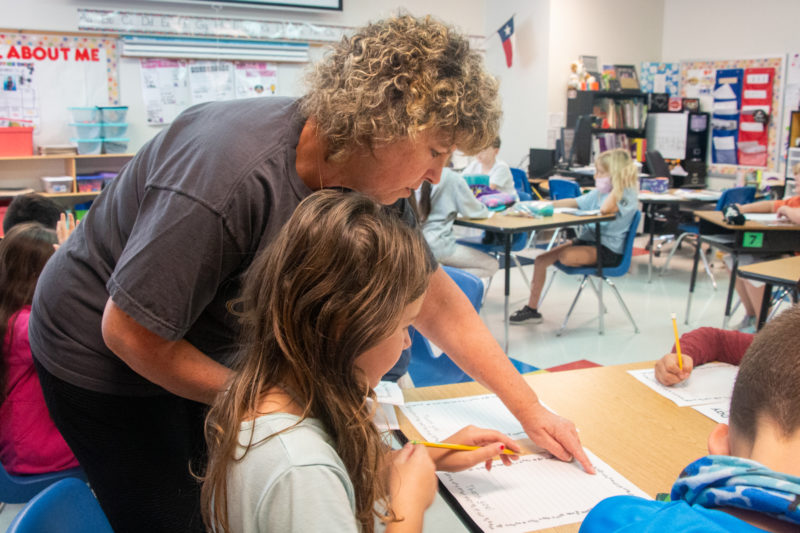After COVID Put Students Behind, Central Texas Schools Are Working to Catch Up
By Marina Garcia
Reporting Texas

Heather Russell reads “The Wall” by Eve Bunting to teach her third-grade class the importance of Veterans Day at Carpenter Hill Elementary School in Buda on Nov. 9, 2021. For the last hour of the school day, Russell’s students wrote a poem or a letter to a veteran. Marina Garcia/Reporting Texas
Thirteen of the 19 students in Heather Russell’s third-grade class at Carpenter Hill Elementary School in Hays County are struggling to meet academic benchmarks. The learning loss is due to a year of virtual schooling because of COVID, said Russell, who has taught for 36 years.
“It was frustrating at best — only because my students and I had many connectivity issues when we were trying to learn virtually from home. We did the best we could, but it was not an enjoyable experience for anybody,” Russell said.
Several studies have shown students, especially those from low-income families, fell behind academically during the pandemic. At the end of the 2020-21 school year, students in first through sixth grades in the U.S. were on average five months behind in math and four months behind in reading, according to a July report from consulting firm McKinsey & Co.
In a series of interviews with Reporting Texas in October, Central Texas school administrators, teachers and parents described how they are addressing academic challenges brought on by the pandemic and responding to a new state law intended to help students catch up.
In June, Gov. Greg Abbott signed House Bill 4545 into law, requiring that schools give extra aid to students who didn’t pass their standardized tests during Spring 2021. The law took effect in August, causing school districts to scramble to meet a new requirement to offer 30 hours of tutoring to students.
The Hays Consolidated Independent School District south of Austin has always had a system to help students who are behind academically, said Derek McDaniel, Hays schools director of curriculum and instruction. House Bill 4545 simply requires the district to expand intervention programs they had already started, he said.
The short notice to implement the law is “what made it a real challenge,” McDaniel said.
The Hays school district hired 25 academic interventionists, double the usual number, to help comply with HB 4545. Interventionists work with students individually, mostly with math and reading, McDaniel said.
In addition to the academic setbacks, the transition to in-person school has presented social and emotional challenges, school officials and teachers say.
“We’ve had to spend a lot of time teaching routines, processes and procedures, and we’ve also had to support that additional social emotional need that has been there,” McDaniel said.
The Hays school board in October approved funding to add 14 behavior aids at elementary schools.
McDaniel is happy schools are holding in-person classes again because it gives faculty a chance to bond with students.
“We’ve been able to give them feedback and guide (students) and correct them on misconceptions and address them in real time,” McDaniel said. “The pandemic made that process extremely slow, and so it has been nice to get our kids back.”

Heather Russell helps one of her third-graders at Carpenter Hill Elementary School in Buda on Nov. 9, 2021. Marina Garcia/Reporting Texas
Round Rock schools have also worked to get more academic interventionists in elementary schools.
Jennifer Harrell, an interventionist at Bluebonnet Elementary in Round Rock, says teachers refer students who are struggling to her for individual attention. “I get a 30-minute block a day with those kiddos,” Harrell said.
The principal at Bluebonnet requested five interventionists, Harrell said. The school previously had two.
Harrell tutors students in small groups and individually before school and during the school day.
“We push in, which means I’m not taking them out somewhere. I’m going into the classroom, and I am doing intensive instruction,” Harrell said.
She also works with teachers to make individualized lesson plans for students.
“Everyone’s doing the best they can,” Harrell said. “I just really do feel like it’s hard on everyone. (The) district is giving us as much as they possibly can, and the kids are giving us as much as they can.”
The Austin Independent School District has rolled out what it calls an “accelerated learning approach” in elementary schools. The approach includes targeted tutoring and personalized student goal setting, Assistant Superintendent of Academics Erin Bown-Anderson said.
In-person classes make it much easier for teachers to connect with students, Bown-Anderson said.
“When students are in the classroom, that is the most important place that we can set a foundation,” she added.
Administrators are working closely with teachers to understand classroom needs and help students reach grade-level standards, Bown-Anderson said.
“The way that I like to describe it … is our accelerated learning plan (is) to help students get back on track and feel good about their learning and feel like they have that confidence to move forward,” Bown-Anderson explained.
In-person classes have also given an opportunity for students to work on emotional needs, and many parents are relieved students are back in the classroom, said Ginny Barrett, a mother of four students in the Austin school district.
Barrett’s children range from kindergarten to high school, and all attend different schools.
“Whenever we were able to get back in person, it was just like night and day. The kids thrive. You know, being in a community, having a teacher in front of them, just (having a) human presence makes a huge difference,” Barrett said.
Not attending school in-person deprived students of the social and emotional outlets and support they need, Barrett said.
“That is definitely felt and probably most likely is a major underlying reason (why) kids are feeling and maybe performing academically the way they’re performing,” Barrett said.
Trying to return to a sense of normalcy after a year teaching through a computer screen has changed her teaching, Hays teacher Russell said.
“Where before I think we took for granted that kids would be … more closely aligned academically with one another,” she said, “now it’s such a variety that we really have to look at kids individually and make an individual plan for them and just look at the curriculum and adjust it to meet their needs.”